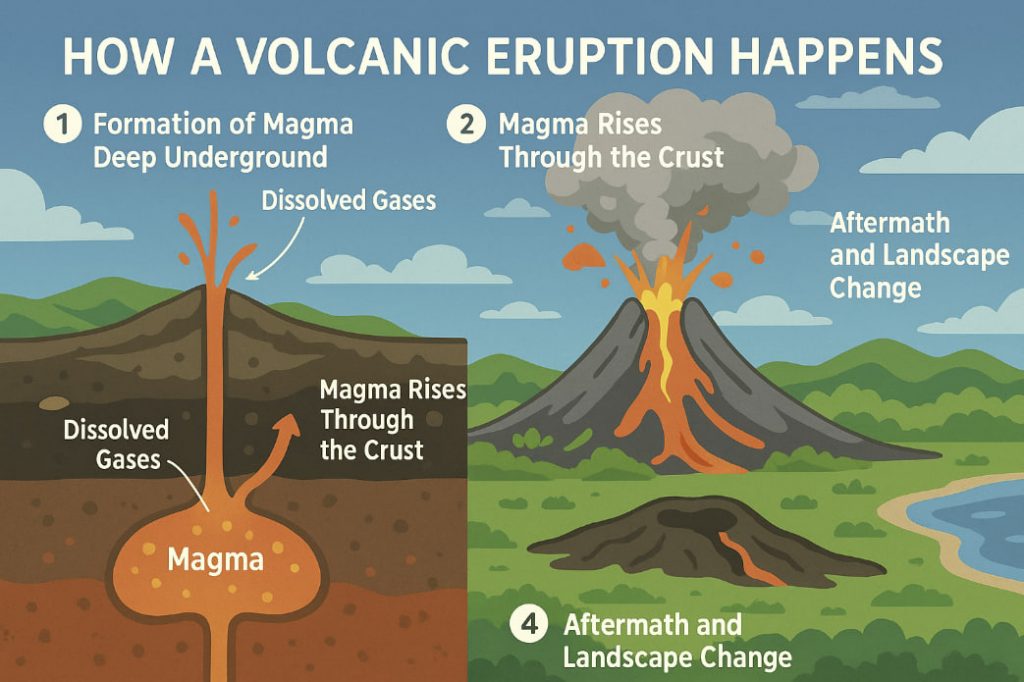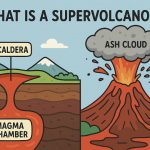A volcanic eruption is one of nature’s most powerful and dramatic geological events. It begins deep within the Earth and ends with the violent release of lava, ash, gas, and rock at the surface. Understanding how eruptions occur helps scientists predict future activity, protect communities, and study the evolution of our planet’s landscape.
1. Formation of Magma Deep Underground
At depths of 50 to 200 kilometers below the Earth’s surface, intense heat and pressure cause parts of the mantle and crust to melt, forming magma. This molten rock is filled with dissolved gases, including water vapor, carbon dioxide, and sulfur dioxide.
This often happens in tectonic settings such as:
- Subduction zones (where one tectonic plate sinks beneath another)
- Mid-ocean ridges (where plates move apart)
- Hotspots (fixed sources of heat in the mantle, like under Hawaii)
2. Magma Rises Through the Crust
Because magma is less dense than the surrounding solid rock, it slowly rises through cracks and magma chambers in the Earth’s crust. As it ascends, pressure decreases, allowing gases to expand — just like bubbles in a shaken soda can.
If the magma gets trapped or blocked, pressure builds up, potentially leading to a violent eruption.
3. Eruption at the Surface
When the pressure becomes too great, the magma erupts through a vent or fissure, bursting onto the surface in one of several ways:
- Explosive eruptions: High-viscosity magma (e.g., rhyolite) traps gases, causing massive blasts that send ash, pyroclastic flows, and rock high into the atmosphere.
- Effusive eruptions: Low-viscosity magma (e.g., basalt) allows gases to escape easily, resulting in a steady outflow of lava.
Eruptions may also involve:
- Lava fountains and lava lakes
- Volcanic lightning within ash clouds
- Lahars (mudflows of ash, water, and debris)
- Tsunamis, if the eruption occurs under or near water
4. Aftermath and Landscape Change
Once the eruption subsides, the landscape is often drastically altered:
- New landforms like craters, calderas, and lava fields emerge
- Volcanic ash can enrich soil but also disrupt air travel and climate
- Life slowly returns — plants and animals recolonize cooled lava over time
Some volcanoes enter a dormant or extinct state, while others remain active for centuries with frequent eruptions.
Can Eruptions Be Predicted?
While exact timing is difficult to predict, scientists monitor:
- Seismic activity (earthquakes near volcanoes)
- Gas emissions (especially sulfur dioxide)
- Ground deformation (swelling or sinking of the land)
- Temperature changes around vents
These signs help volcanologists issue warnings and evacuate areas before major eruptions.
Glossary
- Magma: Molten rock beneath the Earth’s surface.
- Lava: Magma that has erupted onto the surface.
- Pyroclastic flow: A fast-moving cloud of hot gas, ash, and volcanic debris.
- Caldera: A large crater formed by the collapse of a volcano after eruption.
- Lahar: A destructive volcanic mudflow.


